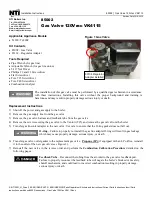
Triton
│
Installation and Operation Instructions - Boiler Location
VS80-130
6
3.0 BOILER LOCATION
In all cases, the Triton must be installed indoors in a dry location where the ambient temperature must be
maintained above freezing and below 100
F [38
C]. All boiler components must be protected from dripping,
spraying water, or rain during operation and servicing.
Consider the proximity to the following when
determining the best boiler location.
System Water Piping
Oil Supply
Electrical Power
Combustion Air / Ventilation Air
Chimney
Components
- Water or flood damaged components must be replaced immediately with
new components (see parts list). Failure to do so may result in fire,
serious injury,
or
death.
Clearances
- Clearances to combustibles represent the minimum clearances required for safety and service.
Recommended clearances are for ease of piping installation, annual maintenance, and service access. Refer to
Table 3-1 and Figure 3-1.
Table 3-1 Minimum Clearances for Installation and Service
Clearances
Dimensions - inches [mm]
Front
Rear
Top
Right Side
Coil Side
Flue Pipe
1, 2
Floor
To Combustibles
24 [610]
5 [124]
24 [610]
5 [124]
24 [610]
9 [228]
Non-combustible
Recommended
36 [915]
24 [610]
24 [610]
24 [610]
24 [610]
9 [228]
Non-combustible
Notes:
1
Minimum clearances from flue pipe to combustibles is 9” for
single-wall pipe; 6” for double-wall pipe (Type-L).
2
Flue pipe clearances take precedence over all other clearances.
Boiler Location
- Even if all installation codes are met, good judgment and common
sense must also be used when selecting a boiler location. Refer to minimum clearances in
Table 3-1 and vent clearances for chimney or direct vent applications.
Figure 3-1 Minimum Clearances to Combustibles
Top
24”
Front
24”
Coil Side 24
”
Right Side 5”
Rear 5
”
Flue pipe clearances
take precedence over
all clearances; refer to
Table 3-1.
Flue Pipe, 9
” minimum







































